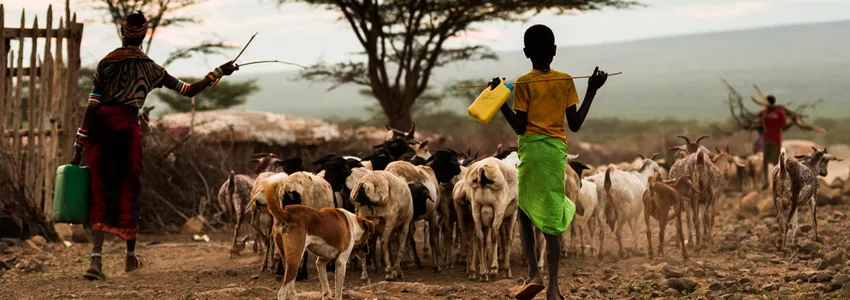
Photo by Dragos Lucian Birtoiu, Shutterstock: Pests and parasites compete with the poor and their livestock in rural economies. A new framework analyzes ecological, economic and epidemiological factors that can trap people in poverty.
Stanford News - July 14th, 2017 - by Rob Jordan
Deep in landlocked Africa, a miracle is unfolding. Less than a generation after a genocidal civil war left it in ruins, Rwanda is defying poverty traps that ensnare many other natural resource-dependent developing countries.
The “land of a thousand hills” today has one of the continent’s strongest economies and healthiest populations. This success story is borne out by a newly developed method for modeling rural poverty that could inform interventions to improve economies, health and ecosystems.
“The livelihoods of the rural poor are literally consumed by other organisms in complex ecological systems,” said co-author Matthew Bonds, a visiting assistant professor of medicine at Stanford. “The environment’s influence on poor rural economies makes them fundamentally different from the economies of more developed countries.”
Rural economics 101
Of the 1 billion people living below the international poverty line, most live in rural communities where the natural resources around them present a double-edged sword. Ecological systems provide subsistence, but also spread high rates of infectious diseases through pathogens carried by agricultural pests, rodents, parasites and other vectors.
“These natural enemies compete with the rural poor for resources,” said co-author Giulio De Leo, a professor of biology at Stanford’s Hopkins Marine Station. “They consume biological capital in the form of human health or crops, livestock, forests, wildlife, soils and fisheries, thus eroding people’s livelihood and well-being.”
The picture is further complicated by the need to balance nutrition and health care with investments in land, livestock and crops. This complex web of interactions leads to grim statistics: More than 75 percent of rural poor people in Sub-Saharan Africa and Southeast Asia die from infectious diseases. It also leads to a poverty trap – the inability to earn enough to save and invest in future earnings. If a farmer or their livestock become unhealthy, income suffers.
Understanding poverty traps
The study, published in Nature Ecology & Evolution, takes a significant step toward understanding persistent poverty and finding solutions for long-term sustainable development. It presents a first-of-its-kind general theoretical framework for modeling subsistence and health of the rural poor by analyzing ecological, economic and epidemiological factors.
For lead author Calistus Ngonghala, a mathematician at the University of Florida, the work hits close to home. “Growing up in rural Cameroon, my family and friends had subsistence lifestyles and my community suffered from a continuous burden of deadly diseases such as malaria and HIV,” Ngonghala said.
The study’s models show that disease transmission and recovery rates are the most consistently important determinants of long-term health and wealth dynamics. The framework also highlights feedbacks, processes and parameters that are important to measure in future studies of rural poverty. They could help identify effective pathways to sustainable development and better predict countries’ resilience to economic, health and environmental shocks.
Case in point: A major, one-time wave of support – such as an injection of capital or agricultural supplies – might be enough to disrupt the vicious cycle of feedback between poverty and disease and set a country on a path of healthy development. However, this widely adopted development approach would only provide temporary relief in some circumstances, the study shows. In those cases, only permanent and sustained system changes can create lasting economic development and public health improvement.
Rwanda is a shining example. It provided broad and robust access to health care for the poor through social insurance systems. Dramatic economic growth followed.
Bonds, an economist and ecologist at Harvard Medical School, is currently a fellow at Stanford’s Center for Innovation in Global Health and a visiting scholar at the Stanford Woods Institute for the Environment. De Leo is a senior fellow at the Stanford Woods Institute for the Environment and faculty director of the Program for Disease Ecology, Health and the Environment.
Co-authors of “General Ecological Models for Human Subsistence, Health and Poverty” include Mercedes Pascual of the University of Chicago and the Santa Fe Institute; Donald Keenan of the Université de Cergy-Pontoise et THEMA; and Andrew Dobson of the Santa Fe Institute and Princeton University.
The research was done in collaboration with the Program for Disease Ecology, Health and the Environment, a joint initiative of the Stanford Woods Institute for the Environment and the Center for Innovation in Global Health at Stanford School of Medicine. It was supported by the National Institutes of Health, the James S. McDonnell Foundation, the National Science Foundation, the Bill and Melinda Gates Foundation and the Stanford Institute for Innovation in Developing Economies.

